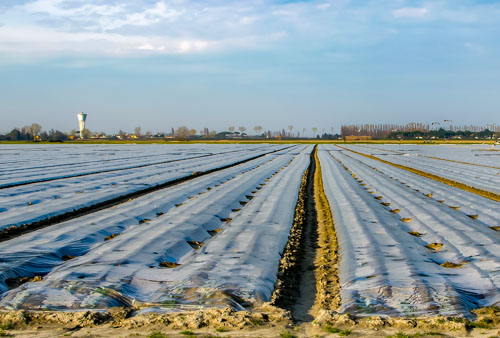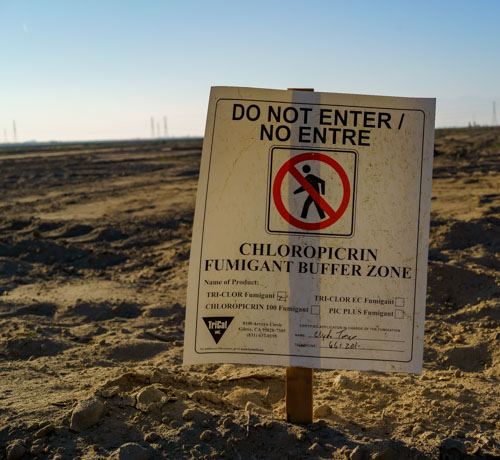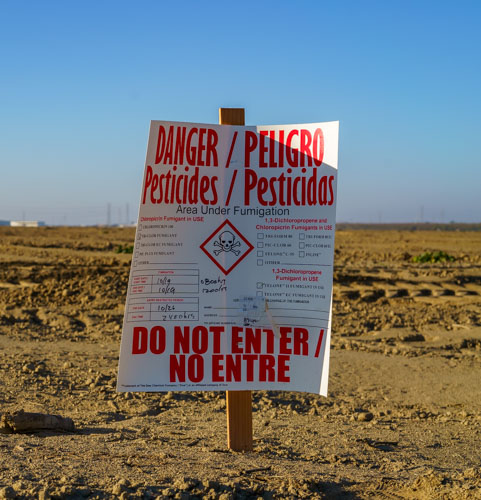Soil fumigation helps farmers to improve and maintain healthy crop soil. Healthy soil provides nutrients, water, and oxygen to the plants. However, soil can also harbor harmful pests and pathogens that can reduce crop quality and yield. For example, nematodes, fungi, bacteria, insects, and weeds. These soil-borne threats can damage the roots, stems, leaves, and plant’s fruit, and sometimes even kill them.
One way to deal with these soil problems is to use soil fumigation. Fumigation is a pre-plant treatment process that prepares the soil before planting. It does so by managing pests and other harmful organisms that could disrupt or prevent growth. Soil fumigation involves the use of special chemicals called soil fumigants that transform from a liquid to a gas. The gas then travels through the soil and kills or reduces the population of pests and pathogens. This improves the condition of the soil for planting and gives the crops a better chance to thrive.
Soil fumigation is especially useful for high-value crops that are sensitive to soil-borne diseases and nematodes. Permanent crops such as almonds, pistachios, cherries, grapes etc. And produce crops such as strawberries, tomatoes, potatoes, carrots, peppers, lettuce etc. Soil fumigation can also help with crop rotation, by eliminating pests and pathogens that could affect different crop types.
Field preparation before soil fumigation
Soil fumigation is a process with specific steps and considerations. Without the right soil texture, proper moisture levels, and correct temperature range, soil fumigation may be ineffective. Therefore, before applying any soil fumigant, the soil needs to be tilled and turned to create a uniform texture. The soil also needs to be moist enough to allow the gas to move through it, but not too wet to prevent it from escaping. The ideal soil temperature for most fumigants is between 50°F and 80°F.
Fumigant application methods

- Broadcast Application. Soil fumigant is applied over the entire field using a tractor-mounted sprayer or injector. This method is suitable for large areas with uniform pest pressure.
- Bed Application. The soil fumigant is applied only to raised beds where the crops will be planted using a bed shaper or an applicator attached to a tractor. This method is suitable for smaller areas with high pest pressure or for crops that require precise placement of the fumigant.
- Drip Application. The soil fumigant is applied through drip irrigation lines that are buried in the soil or laid on top of it. This method is suitable for crops that are irrigated using drip systems or for fields with irregular shapes or slopes.
- Covering the Soil. After applying the soil fumigant, the soil may be covered with a plastic tarp or film to prevent the gas from escaping too quickly and to increase its effectiveness. The tarp may be removed after a certain period of time depending on the type of fumigant and the weather conditions.
Wait period after fumigation
After applying the soil fumigant and covering the soil if needed, there is a waiting period before planting can begin. This period allows the gas to disperse through the soil and kill or reduce the pests and pathogen populations. It also allows the gas to decompose into harmless compounds that do not affect plant growth or surounding human health. The waiting period varies depending on the type of fumigant, the application method, the soil conditions, and the crop requirements. It can range from a few days to several weeks.
After the waiting period is over, the soil is ready for planting. Crops can be planted directly into the treated soil or transplanted from seedlings grown in pots or trays.
Common Soil Fumigant materials
There are many types of soil fumigants available in the market, each with different chemical compositions, modes of action, pest spectra, application methods, safety measures, and regulations. Some of the most widely used ones are:
- Chloropicrin. Chloropicrin is a colorless liquid that turns into a colorless gas when applied to the soil. It is used to control soil-borne diseases caused by fungi and bacteria, such as Fusarium wilt, Verticillium wilt, Phytophthora root rot, and Pythium damping-off. It can also suppress some nematodes, insects, and weeds. Chloropicrin is often used in combination with other fumigants to enhance their efficacy and reduce their toxicity.
- 1,3-Dichloropropene. This material is a clear liquid that turns into a colorless gas when applied to the soil. It is used to control plant parasitic nematodes, such as root-knot nematodes, cyst nematodes, and lesion nematodes. It can also suppress some fungi, bacteria, insects, and weeds. 1,3-Dichloropropene is often used in combination with chloropicrin or other fumigants to broaden their pest spectrum and reduce their dosage.
- Methyl Bromide. Methyl bromide is a colorless liquid that turns into a colorless gas when applied to the soil. It is a broad-spectrum fumigant that can control almost all soil-borne pests and pathogens, including nematodes, fungi, bacteria, insects, weeds, and even rodents. However, methyl bromide is also an ozone-depleting substance that contributes to global warming and has been phased out in most countries under the Montreal Protocol. It is only allowed for critical uses where no alternatives are available or effective.
Benefits of Soil Fumigation
Soil fumigation can provide many benefits for farmers who use it properly and safely. Some of the benefits are:
- Increased Crop Yield and Quality. Soil fumigation can eliminate or reduce the damage caused by soil-borne pests and pathogens that can reduce crop yield and quality. By creating a healthy soil environment for the plants, soil fumigation can increase crop productivity and profitability.
- Reduced Pest Resistance and Reinfestation. Soil fumigation can kill or reduce the population of pests and pathogens that may have developed resistance to other pest management methods, such as crop rotation, cultural practices, biological control, or chemical control. Soil fumigation can also prevent or delay the reinfestation of pests and pathogens from neighboring fields or other sources.
- Improved Crop Rotation and Diversity. Soil fumigation can enable farmers to grow different types of crops in the same field without worrying about soil-borne diseases or nematodes that may affect them differently. Soil fumigation can also allow farmers to grow crops that are otherwise difficult or impossible to grow due to soil problems.
Risks of Soil Fumigation
Soil fumigation is not without risks or challenges. Some of these risks are:

- Human Health Hazards. Soil fumigants are toxic chemicals that can cause adverse health effects in people who are exposed to them during or after application. These health effects range from mild and reversible eye irritation to more severe and irreversible effects, such as respiratory distress, neurological damage, or cancer. Therefore, soil fumigants must be handled with care and caution by trained and certified applicators who follow strict safety measures and regulations.
- Environmental Impacts. Soil fumigants are volatile chemicals that can escape from the soil into the air at the application site or nearby areas. This can cause air pollution and odor problems that may affect people, animals, plants, or property. Some soil fumigants can also leach into groundwater or runoff into surface water, causing water contamination that may affect aquatic life or human health. Some soil fumigants can also deplete the ozone layer or contribute to global warming due to their greenhouse gas potential.
- Regulatory Restrictions. Soil fumigants are highly regulated pesticides that require special permits, labels, labels instructions (LIs), buffer zones (BZs), application rates (ARs), waiting periods (WPs), personal protective equipment (PPE), emergency response plans (ERPs), notification requirements (NRs), recordkeeping requirements (RRs), stewardship programs (SPs), training programs (TPs), certification programs (CPs), compliance programs (COPs), enforcement programs (EPs), monitoring programs (MPs), risk mitigation measures (RMMs), best management practices (BMPs), good agricultural practices (GAPs), integrated pest management (IPM) strategies
How AgNote can help
Soil fumigation is a process that involves applying chemicals to the soil to control pests, diseases, and weeds. It can improve crop yield and quality, but it also poses some risks to human health and the environment. Farm management software can help farmers by providing tools for planning, monitoring, and documenting the fumigation process. Some of the benefits of having farm management software are:
- It can help farmers comply with the regulations and guidelines for soil fumigation
- Optimize the timing and frequency of soil fumigation, based on factors such as soil temperature, moisture, pH etc.
- It can help farmers track and record the fumigation activities, such as the date, time, location, weather conditions, fumigant type, amount and concentration, application method and equipment, buffer zones and re-entry intervals.
- It can help farmers analyze the effectiveness and impact of soil fumigation, by comparing the crop performance, pest population, soil quality and environmental indicators before and after fumigation.
You can try AgNote (farm management software) today, register today for a free seven-day trial.
